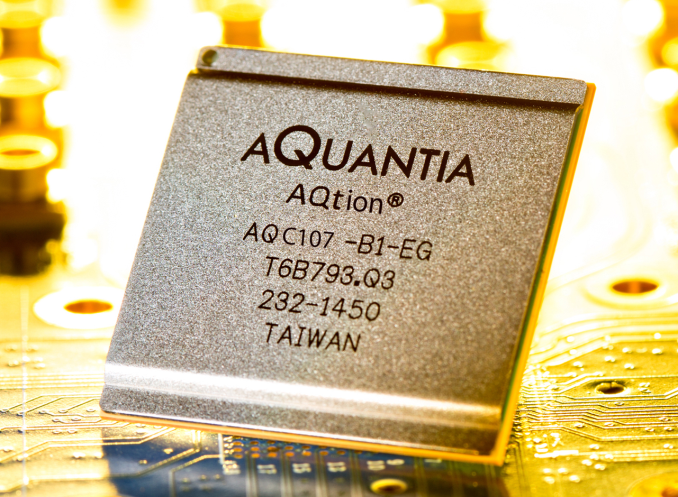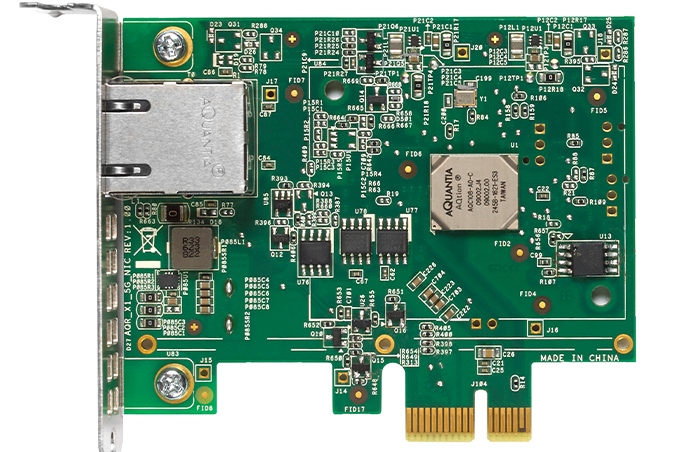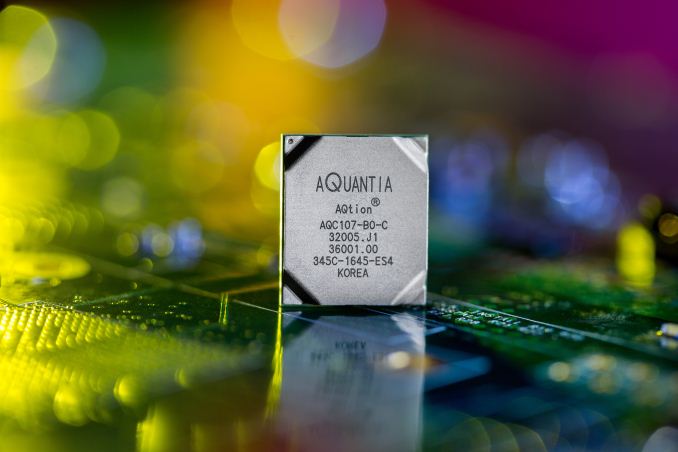Aquantia Launches New 2.5G/5G Multi-Gigabit Network Controllers for PCs
by Ian Cutress on December 14, 2016 2:00 PM EST- Posted in
- Motherboards
- Systems
- Networking
- Aquantia
- 2.5GBase-T
- 5GBase-T
- AQtion

Frequent readers of AnandTech will have recognized that our coverage of higher speed network interfaces over copper, particularly 10G, for the home and business has increased recently. This is perhaps no surprise: 1 Gbit speeds for wired networking have been the norm for fifteen years on consumer level products, but there are certainly some users that require faster network availability in their home/business due to the increased number of devices and size of content, particularly video content, that has exploded this decade.
Arguments aside about external network availability and infrastructure, streaming inside the home or in the office typically comes down to a couple of key factors – the size of the networking backbone and the capability of each device connected to it. For consumer infrastructure that stays on copper, 1Gbit or teamed connections has been the limit for long distance Cat 5a/Cat 6 cabling, which is fairly cheap, and some solutions have moved to the more expensive 10GBase-T solutions which are power hungry, more enterprise focused and simultaneously a lot more expensive by at least an order of magnitude. 10GBase-T also requires Cat 7 cabling for any serious distance requirements.
Back at the Supercomputing 2015 show, there were several talks about the utility of 2.5G and 5G copper networks. These discussions were primarily focused in the data-center and high-performance categories rather than the consumer, and at the time I commented that it was likely where these standards were to stay as it would require a significant step up to drive a 2.5x/5x adoption for the consumer over a 10x adoption. It was expected that the cost of 10G would start to come down, but over 2016 it has remained consistent, much to the chagrin of enthusiasts.
At the time in 2015, the 2.5G/5G standards were not yet ratified by IEEE. There were chips in the market, solely from Aquantia, for enterprise configurations that were happy to go with an evolving standard for their solution. From September 2016 this changed, and the standards have been ratified with Aquantia, Intel, Cisco and others all involved in the specification. Aquantia’s earlier generation silicon adhered to the standard, and has been deployed in a number of enterprise backbone deployments to the tune of 5M ports a year. Today’s announcement surrounds the launch of two new controllers based on the multi-gigabit standards aimed at more consumer level solutions – specifically ‘client connectivity in enterprise, gaming and SMB applications’.
The chips are small, 11x7mm, and use Aquantia’s expertise in both MAC/PHY management to produce the AQtion brand (as in, ‘Action’), to complement the AQrate (‘accurate’) currently in the ecosystem. The two AQtion controllers are single channel, single port solutions and differ in their speed support:
AQC107: 100M/1G/2.5G/5G/10G
AQC108: 100M/1G/2.5G/5G
The AQC107 will support 10GBase-T on Cat 6 copper cables, adhering to the 8 02.3an standard, although at a different set of distance limitations. Both chips are targeting a large market of motherboards, routers, office PCs, switches, routers, dongles and anything that a consumer or small/medium business might purchase. This includes add-in PCIe cards. Both chips will support up to PCIe 3.0 x4 connectivity, going down to PCIe 2.0 x1 as required (peak rates will be limited in this mode, obviously).
On price comparisons to current gigabit solutions, Aquantia was unwilling to release the information given that individual contracts will govern the price but they were willing to say that a number of partners are already in production of their hardware. Aquantia wanted to make it clear that they will leave it up to their partners to market and promote the feature set of the controller. This will become important, especially as the motherboard PC networking controller market has a number of options.
Currently the big players are Intel and Realtek, using the I219-V/LM and RTL8111E/F families respectively. Certain versions of the controllers have more management functions, or prioritize some capabilities over the others, and key defining elements are both cost and consumer requests (distributors or clients). Rivet Networks is also a significant player with their Killer brand of networking ICs, focusing primarily on the gaming crowd with controller specific QoS features that are promoted to gamers and prosumers, and used extensively with MSI laptops and MSI/Gigabyte motherboards. Technically Realtek has the Dragon brand here, although we’ve only seen them on one generation of ECS motherboards so far. It’s important to note that only the Killer ICs come with any form of default controller software aimed at consumers for QoS and traffic shaping; Intel has management software at a more admin level. We asked Aquantia about additional consumer software, and was told that currently none is bundled but they are aware of the current market.
For now, the AQtion 2.5G/5G controllers coming to market look to be a premium component, destined for high-end notebooks/PCs, and if the pricing is right, more expansive than the current array of 10G integrated options. One of the issues Aquantia will have, which they also acknowledge, is the switch problem that currently stops 10G being more widespread – the lack of consumer grade and consumer budget level switches. We were told that there are some enterprise models of 2.5G/5G switches currently for more backbone type of work, and it will be up to Aquantia’s partners to spot opportunities in the consumer market. From a personal perspective, the switch side of the equation will be the slowest to change and be a defining aspect for the widespread adoption of this technology. We’ve seen this with 10G, or the fact that the Killer gaming NICs do not have corresponding switches/routers to assist in a number of features that might become irrelevant in a general network. Publicly Aquantia isn’t stating which switch developers they are working with, and as before, leaving those companies to decide/announce their product lines, but I think the switch aspect will be more important to watch over 2017.
On performance metrics, Aquantia have told us that the AQ107 can achieve 9.5 Gbps in each direction in the 10G mode with a CPU utilization of 12-20%, and in 5G mode it can do 4.6 Gbps in each direction with 6-14% CPU use. Due to the higher clock rate of the controller, in 1G mode the controller is quoted as having has lower latency than standard 1G controllers. The AQC107, in 5G mode, will have a typical power consumption around 3W when in use.
We were told that the chips support Wake-on-LAN and Energy Efficient Ethernet standards for power saving (wake-up in the microsecond range), as well as various offloads for reducing CPU use (LSO, LRO, header checksum, receive side scaling). QoS features allow for 32 queues/traffic in each direction, as well as rate shaping capabilities. Drivers will be available for all major flavors of Windows (7 to 10, 32/64-bit), Linux and macOS.
Aquantia stated that they are using their deep contacts at TSMC and GloFo for their product range, but stopped short of stating which process or which node they are using. Behind the scenes we have already have a sniff of upcoming products using Aquantia’s solution that are due to be announced over the next few months.
Source: Aquantia












32 Comments
View All Comments
evilspoons - Wednesday, December 14, 2016 - link
"Due to the higher clock rate of the controller, in 1G mode the controller is quoted as having has lower latency than standard 1G controllers"Errrwhat?
BrokenCrayons - Wednesday, December 14, 2016 - link
Translation: The chip running the NIC is faster because it was built to handle > 1Gbit data rates. When it's stuck at 1Gbit, all that extra processing power means it processes packets more quickly than adapters that are only built to handle 1Gbit and results in lower network latency.bcronce - Thursday, December 15, 2016 - link
I'm already able to measure as low as 0.008ms on my home network. That's my desktop pinging my PFSense firewall through my HP 1Gb switch.According to my switch specs, a 64byte packet has a maximum latency of 2.3us. Seeing the ping must go through the switch twice, that is already 4.6us, or 1/2 of the total latency. Now you need to include interrupt and processing time on the firewall to receive and respond to the ICMP ping. There is also the time for my desktop to receive and processing the ping.
I am sure the NIC adds some amount of latency, but I can't see it being very much. Probably less than 1us.
BrokenCrayons - Thursday, December 15, 2016 - link
You're absolutely correct that the added latency introduced by the NIC is minimal. However, the claim that there's less NIC-induced processing latency is also probably true. It might be an insignificant difference you'll never notice at the keyboard, but the claim can probably be made truthfully and might entice prospective customers regardless. It's not snake oil because its factual, but it's probably a gain that won't easily translate into some tangible benefit.It's a lot like Bigfoot Networks' claims about Killer NICs improving gaming performance by shuffling packets to your local router more quickly. Sure, the old Killer NIC DOES do that, but once those tasty packets leave your local LAN, they're at the mercy of a dozen ISP-owned routers and thousands of miles of wires that all don't give even the tinest crap about the Killer NIC that generated them. Did it make a difference? Yeah it did. Does it really benefit you that it did? Maybe not.
willis936 - Thursday, December 15, 2016 - link
There are unlisted performance metrics on NICs. Try blasting out as much traffic as you can to as many addresses as you can and see if the NIC is actually putting out 1 Gbps of traffic and if the packets are getting issued within 1 ms.willis936 - Thursday, December 15, 2016 - link
Does it matter for a home network? No but neither does 2.5G and 5G link rates tbh. The router fast path throughput will be the limiting factor before anything else.bcronce - Thursday, December 15, 2016 - link
I have an Intel i210 on my desktop and i350 on my firewall. Using iperf to send 64byte UDP packets, I am able to send 1Gb/s of 64byte packets. My firewall registers about 1.48mpps of incoming which is line rate. My desktop is hosted with well over 50% cpu usage, but my firewall is mostly idle in the teens.If all I want to do is do a TCP file transfer, then my desktop only uses about 4% cpu to transfer 114MiB/s over SMB.
BrokenCrayons - Wednesday, December 14, 2016 - link
I don't see this thing taking off. It's got a few factors working against it:-1Gbit is quick enough for most wired network needs.
-Wireless is easier, simpler, and has dominance in a majority of places
-10Gbit already exists
I think it makes more sense to address 10Gbit ethernet's shortcomings to reduce power requirements and costs while extending range. Efforts there would more directly address situations where 1Gbit is insufficient. Besides that, if 10Gbit were really that attractive to the world, costs would already be falling due to demand driving competition and forcing innovation. The reality is that the market forces aren't there in sufficient quantities to justify an intermediate speed solution.
johnthacker - Wednesday, December 14, 2016 - link
Counterpoint: The install base of Cat 5e and Cat 6 is far, far greater than that of Cat 6a and Cat 7 (or fiber), and rewiring is expensive. That alone makes this a much cheaper solution than 10GbitE (acknowledging that, yes, you can run 10GBASET over Cat 6 at a reduced range, 55m, but this would provide fallback to intermediate rates).Wireless definitely isn't dominant in the places where I work, and it certainly isn't easier or simpler. There's a lot of places that could use this as an upgrade path that wouldn't consider rewiring for 10GbE.
kpb321 - Wednesday, December 14, 2016 - link
It's tricky. I don't think there is a solution to the 10Gb issues just waiting for enough demand/effort spent to find it. Fundamentally you are just doing something that is hard to do and process improvements are probably the only thing that will get power/costs down to more consumer friendly levels. Even if that does happen it doesn't do anything to address the cables portion of things. The higher frequencies used by 10Gb require higher quality cables that can support those frequencies.2.5Gb and 5Gb have a chance to come in at price points that could actually be viable in the consumer market. Heck Intel could include 2.5Gb or 5Gb in their next chipset and jump start things over night.